|
August 2011 - October 2011 |
| |
|
|
 |
|
 |
| |
Publisher:
Chairman Ching-Fuh Lin Editors:
Professor I-Chun Cheng, Ms. Hsiao-wen Lin November 30,
2011 |
| |
|
 |
|
Congratulations!
Chi-Shuen Lee, an EE department student under the direction of GIPO professor Lung-Han Peng,
wins the "2010 undergraduates' case study projects Research Creation Award".
Congratulations!
Jen-Tang Lu, a GIPO student under the
direction of Prof. Chi-Kuang Sun,
wins 2nd place in "2011
Youth Thesis Award, The Chinese Institute of Electrical Engineering".
Congratulations! The
GIPO students' team under the direction
of Prof. Jr-Hau He, wins the
"IUMRS International Conference in Asia
Outstanding Paper Award (one paper) &
Excellent Poster Award (two papers)".
Congratulations! The
GIPO students' team under the direction
of Prof. Jr-Hau He, wins the
"2011 SAMPE student thesis Ke-Young
Award (outstanding)".
Congratulations!
Hung-Chih Chang, a
GIPO student under the direction of
Prof. Jr-Hau He wins the "2011 Lam
Research Award (excellent)".
|
|
 |
|
 |
|
| |
|
 |
|
July
Photonics Seminar Highlights
(Compiled by Li-Chi Yao) |
|
|
July 11th
(Monday), 2011, 2:00 pm |
|
Speaker: |
Prof.
Roel Baets
(Ghent
University
and IMEC) |
|
Topic: |
Speech 1: Silicon
photonics: the integration of light
sources
Speech 2: Introduction to EMMP
(future: EMSP) program |
| |
Prof. Roel Baets
visited GIPO on July 11th
(Monday) and spoke on the topics of:
"Silicon photonics, the integration
of light sources" and "Introduction
to EMMP (future EMSP) program" at
Auditorium 105, EE Building II. His
speeches were exciting and
well-considered in every respect,
and he interacted well with the
audience. GIPO professors and
students participated in this event
with enthusiasm and gained a great
deal of knowledge from it.
|
| |
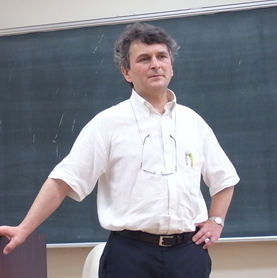 |
|
The speaker:
Prof. Roel Baets |
|
~ Self introduction of
the President of the GIPO
Students’ Association, academy year 2011 ~
 Hi,
everyone! I'm this year’s new president
of the GIPO students’ association,
Chi-Fan Huang. I'm so happy to
be able to have the opportunity to serve
my GIPO classmates and teachers. First
of all, I would like to thank
Liang Liao, a doctoral student in
Prof. Ding-Wei Huang's laboratory.
Liang Liao was a member of NTU
student association since he was an
undergraduate student at NTU. Therefore,
he is experienced in organizing student
events and is the best candidate for
this term. However, due to a heavy study
load, he did not take the position and
recommended me instead. I appreciate
Liang Liao's kindness and also the
thorough support from my advisor - Prof.
Way-Seen Wang, who’s positive and
optimistic outlook in study and in life
has taught me a great deal.
GIPO is a large
group. In order to win honor for NTU and Taiwan, everyone's very dedicated to
his/her studies. However, this does
cause many of us to neglect the people
around us. It seems that there is not as
much interaction between GIPO students
as there was during our undergraduate
years. I sincerely hope that, during my
term, through the GIPO's social events
and recreational activities, our
classmates and teachers can be away from
the equipments and research papers
occasionally and interact more with each
other. This way, everyone can make
friends outside of his/her laboratory,
improve the interpersonal relationships
and reinforce his/her identity at GIPO.
During the first
semester, we are going to hold the
traditional mid-autumn festival meal
party again. In view of the fact that,
on the once-a-year mid-autumn festival
day, when the moon is full and most
family members reunite, many GIPO
teachers and students are still
wrestling with work and studies, we
would like to create a unique party and
bring a happy mid-autumn festival to
everyone in the GIPO. Please mark your
calendar for the occasion, enjoy the
meal, relax, and chat with the
classmates. After the hearty meal, we
will further invite you to participate
in our mystery activity. In the second
semester, we certainly will not miss the
much-anticipated GIPO ball games. As
usual, we will decide what kind of ball
game we will have this year from a poll.
We hope that, aside from the laboratory
experiments and paper work, we can take
good care of our own health. By
participating in sports together with
classmates, we can, at the same time,
experience the importance of team work.
Nevertheless, being
graduate students, we are supposed to
focus on our studies and don’t have as
much time left for fun as most
undergraduates do. Therefore, when we
hold these events, we will try our best
not to affect your study time. Please
let us know if you have any concerns
about these events. The role of the
association is to encourage our students
to develop better relationships with
others, and, hopefully, to be the bridge
between students and teachers. During
the coming year, it is our hope that we
can give you something special,
something other than experiments or
research papers, for you to remember
your years as a graduate student. By the
way, if you are passionate about the
association's work and wish to create a
unique graduate life, you are most
welcome to join us. Please contact me as
soon as you can. Thank you all!
~ GIPO summer camp for undergraduates, 2011 ~
(Time:
July 13th~15th, 2011;
Location: Barry Lam hall & EE Building
II, NTU)
Composed by: Chi-Fan Huang, President, GIPO Students’ Association
Taiwan's optoelectronics industry has
recently developed vigorously, both in
quality and quantity, and has become an
indispensable part of the world. With
the desire to sow and plant seeds, GIPO
has held the summer camp every year to
attract creative and prospective youth
to join this field. Through exciting
speeches, experiments and tours,
participating students have learned with
their hearts, done with their hands and
seen with their own eyes. They certainly
have gained a lot from the camp.
Dr. Chia-Wei Sun, a researcher of the
Biophotonics Interdisciplinary Research
Center, National Yang-Ming University,
delivered the first speech on the first
day. Dr. Sun is also a distinguished
GIPO alumnus. He studies methods of
using optoelectronics techniques for
early detection of serious inherited
diseases, such as Parkinson's disease.
Next, Jian-Jang Huang, a GIPO professor
specialized in solid-state lighting,
spoke on "The development of Taiwan's
solid-state lighting technology". The
value of Taiwan's LED output has been
placed within the world's top three.
When LED goes from screens to lighting
devices, what kind of advantage does
Taiwan have and what kind of approach
should the optoelectronics industry
take? Prof. Huang answered students'
questions incisively, increasing
students’ belief that Taiwan's
optoelectronics industry has unlimited
potential. In the afternoon, Prof.
Hoang-Yan Lin gave a lecture on the
principles and processing procedures of
the three experiments set up by GIPO.
Then the students performed the hands-on
experiments, which allowed them to
better understand the principles shown
in the textbooks and made a deeper
impression, since they were learning and
practicing at the same time. Afterward,
we visited Prof. Lung-Han Peng's, Prof.
Ching-Fuh Lin's and Prof. Chih-I Wu's
laboratories. These laboratories cover
the three major domains of
optoelectronics - organic
optoelectronics, inorganic solar cells,
and solid-state lighting devices.
Through interactions with laboratory
researchers, the students realized that
GIPO's study resources are abundant and
the researchers are excellent. These
certainly have inspired the students to
apply for GIPO for their graduate study.
The next morning, at 8 AM, while the
temperature rose up to 33 degrees, we
got together at NTU main gate and were
ready to visit Hsinchu Science Park -
the stronghold of Taiwan's
optoelectronics industry. This time we
visited two world-class manufacturers -
Epistar Corporation and AU Optronics
Corporation. Epistar is Taiwan's largest
LED epitaxial grain manufacturer. It
makes 80% of the world blue chips and
60% of the world red chips. AUO is one
of the world's three largest display
panel manufacturers. It has complete
production lines for large, medium and
small panels. After having a tour in
Epistar's clean room and offices, we
went to the conference room to hear the
superintendent's briefing and an
experience-sharing report from an
Epistar's employee, who is a GIPO
alumnus. To my surprise, after the
briefing, the students talked with the
superintendent for one hour, showing
that they were very interested in the
employment opportunities of
optoelectronics graduates. At AUO, we
were received by the director of the
human resource department personally.
Then, the OLED superintendent briefed us
the AUO's strategy in OLED display
panel. To our astonishment, we then
realized that AUO had a whole set of
recreational facilities and its gym
occupied a whole building, which made us
long for working in such a corporation.
We went back to NTU when the night came,
and we all felt that it was a worthwhile
trip.
In the early morning of the 3rd
day, Prof. Jui-che Tsai delivered a
speech on "the application of MEMS
devices in fiber optic communication".
Next, Prof. Ding-Wei Huang delivered a
wonderful speech concerning "the general
situation of the development of optical
communication". As human information
transmission quantity grows bigger and
bigger, optical communication has played
a very important part, and it is also
the focus of GIPO's development. Next,
Prof. I-Chun Cheng delivered a speech
concerning "the general situation of the
GIPO's development in solar cells". Due
to energy crisis, solar cell technology
has developed quickly in recent years,
and Prof. Cheng is one of the leading
experts in this field. Last, Prof.
Hoang-Yan Lin delivered a speech
concerning "the development of display
technology and its industry". Display
technology is not just a semi-conductor
industry, but, due to its involvement
with human vision, a more complicated
design technique. Prof. Lin's speech
made students realized that there is
much experience and knowledge hidden
behind the colorful monitors. After the
speeches, Prof. Ching-Fuh Lin, the
chairman of GIPO, awarded the students
with certificates and held a forum with
them. The chairman made us understand
the current status of optoelectronics
industry easily. He analyzed in detail
what Taiwan's advantages in this field
were and how GIPO ranked in the world's
study. Then, he summarized the three
days' lessons by giving us an overview
in energy, communication, display,
biomedicine and lighting. From his
introduction, we realized that GIPO's
published periodical papers had not only
kept pace with world's famous
universities, but were even transcending
them.
I'm delighted to have the opportunity to
be involved in this year's
optoelectronics summer camp, which gives
me a sense of duty to pass down our
traditions. It's the professors, who
delivered the speeches, and the
students, who helped to interpret the
experiments, who made this camp
versatile and remarkable. We would like
to thank Li-Chi from the GIPO office for
her time and hard work in organizing
this event. Also, thank you to the
students, Chi-Hsing, Yu-Feng, Li-Chuan,
Tsung-Min and Prof. Hoang-Yan Lin's
laboratory's research team, who
volunteered to help. And, of course, we
have to thank the chairman for his kind
support towards this camp, which has
made everything possible.
|
 |
|
 |
|
| |
|
 |
|
~ Visiting Epistar Corporation ~
Time:
July 14th, 2011
Composed by:
Tzu-Yu Chen
Visitors: Chairman Ching-Fuh Lin, Vice Chairman Chih-I
Wu, Prof. Hoang-Yan Lin, Prof. Yih-Peng Chiou, Prof.
I-Chun Cheng, Prof. Jr-Hau He,
Post-doctoral researcher
Kun-Yu Lai, Doctoral
student
Tz-Shiuan Peng
and Doctoral student
Hsiang-Chun
Wei
Epistar Corporation is
located in Hsinchu Science
Park, specialized
in producing HB-LED, epitaxial chip and grain.
And, it does so using its own MOVPE technique to
develop HB-LED series. Epistar's manager,
Aisen Liu, received us personally, and Ming-Hsun Hsieh,
the vice general manager of the PR center, and
his crew held a research-technique-exchange
seminar with us. The professors briefed the crew
on their field of research and specialties, and
then discussed the possibility of cooperation
with them. Afterward, Hsueh-Shun Wang,
deputy manager of Epistar, accompanied us to
inspect their transferable research
instruments. This visit concluded smoothly after
that. It is our hope that we can establish a
long-term research cooperation relationship with
Epitstar through this interaction and visit.
|
 |
|
A group photo of GIPO professors, at Epistar's
factory |
|
|
 |
|
GIPO chairman, Ching-Fuh Lin, briefing Epistar's
crew |
|
|
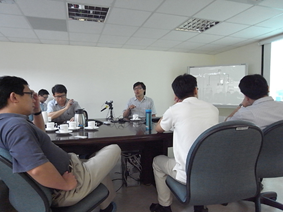 |
|
Hsiang-Chun Wei, a GIPO doctoral student, representing Prof.
Guo-Dung Su, briefing Epistar's
crew |
|
|
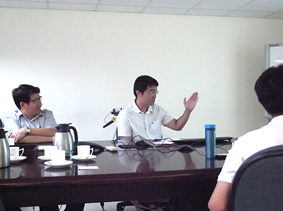 |
|
Tz-Shiuan Peng, a GIPO doctoral student,
representing Prof. Lon A. Wang, briefing Epistar's
crew |
|
|
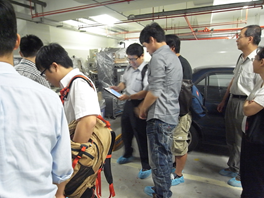 |
|
Inspecting Epistar's
transferable
research
instruments |
|
~ A Summary of the Visit to Three American Universities
~
【Part I】
University of California, Los Angeles (UCLA), August 19, 2011
Composed by:
Prof. Jian-Jang Huang, GIPO
Frankly speaking, this is not the 1st
time I visited UCLA. Ten years ago, when I was
studying in the USA, a classmate of mine,
studying in UCLA, showed me around the campus
for an entire afternoon. In addition, GIPO has 2
excellent UCLA alumni as well. Therefore, I have
been quite impressed with their outstanding
research. However, until this summer, I have not
yet had the opportunity to interact with the EE
department professors' laboratories of UCLA.
In the early morning of August 19, under the
lead of chairman Ching-Fuh Lin, we, Prof. Chih-I
Wu,Yuh-Renn Wu, Jr-Hau He and myself, five in
all, went to the UCLA Engineering IV Bldg.
Originally, we thought we were going to report
our studies in turn and discuss with UCLA
professors. Much to our surprise, UCLA EE was so
attentive as to make this visit a seminar with
snacks and beverages, even though the visit
occurred during summer vacation. About 10
professors and twenty-some graduate students
took time from their busy schedules to attend
this event.
First of all, Prof. Chang, the head of UCLA EE
department, reported their profile. They have
many academicians of the National Academy of
Engineering, and, of course, many fellows of
several associations. These scholars have
written many textbooks which we read frequently,
and have made several breakthroughs which have
affected modern technology and our lives. It was
an excellent report, and UCLA deserves to be one
of the America's top universities. Next, Prof.
Bahram Jalali delivered a speech on "Evolution
of photonic time stretch: from analog to digital
conversion to blood screening". Prof. Jalali is
a famous scholar in optics. He has made
breakthroughs in photonic time stretch, and has
applied it to blood screening. Moreover, I
personally feel that, perhaps because of the
prompt from their funding agency or the
emergence of some topics in related fields,
UCLA's optoelectronics research may have certain
connections with bio. For example, Prof. Eric
Chiou's speech "Photothermal nanoblade for
single cell surgery and cargo delivery" and,
Prof. Ozcan's student, Ting-Wei Su's speech "Lensfree
on-chip microscopy for global health
applications" all have integrated MEMS and
optical lens' design with bio. Next, Mr.
Scofield delivered " Nanopillar-based photonic
crystal lasers: a bottom-up approach to photonic
integration".
We visited the laboratories in the afternoon.
Among them, Calif. Nanosys Inst. (CNSI) is
worth mentioning. Despite the fact that UCLA has
already been a first-class distinguished
university, CNSI is still working hard to invest
in creativity stimulation and in the top-notch
research of the next generation. Perhaps it is
only my opinion, but, in comparison, NTU is
still revolving around some KPI, and takes
excessive seriousness in numbers, such as paper
numbers, citation numbers and ranking numbers.
This visit has refreshed my thinking.
We would like to thank Mau-Chung Chang, UCLA EE
department head, for his banquet in the evening.
Besides his distinguished research in RF, Dr.
Chang is also very cultivated in speaking. He
chats charmingly with us, and we all had a
wonderful time. From our conversations, I have
also learned how to invest in real estate: the
price of the housing in the areas by mountains,
rivers or seas, the limited supply of land will
rise more easily.
【Part II】
University of California, Santa Barbara (UCSB), August 29, 2011
Composed by:
Prof. Yuh-Renn Wu, GIPO
After attending the SPIE meeting, GIPO
professors took the opportunity to visit the
nearby UCSB. The main purposes of visiting UCSB
were to reach a bilateral cooperation and
interaction agreement, to exchange education
viewpoints concerning double degrees, and to
reach some research cooperation alliance
agreement. As we know, UCSB is not a traditional
Ivy League university; however, in recent
placings, it is rising fast, especially in
materials and electronics engineering.
Particularly, after the establishment of
California NanoSystems Institute (CNSI) and the
emergence of several Nobel Prize winners or
prospective winners, UCSB's fame is increasing.
It is now a key university famous for science
and technology. Among the departments, the
material department has risen the fastest; it is
currently ranked No.1 in the U.S. It makes
people wonder: how did UCSB rise so quickly?
Since I had the privilege of being subsidized by
the National Science Council and NTU to study
here as a visiting scholar since this September,
I took the responsibility to contact and consult
with the related people concerning this visit.
In the early morning of a clear day, I drove a
friend's car to pick up chairman Ching-Fuh Lin
and Prof. Guo-Dung Su and headed to UCSB EE
department. With the help of student Lin, we met
Prof. Cheng, the ex-head of EE, without any
difficulties, and exchanged viewpoints
concerning both sides' research topics. Because
they had been good friends, and it was Prof.
Cheng who helped to prompt this visit, the talk
was lively and animated. Next, we went to visit
Prof. John Bower. Since Prof. Bower had
cooperated with GIPO Prof. Chi-Kuang Sun before,
he received us most cordially. The chairman
shared with him the newest achievements of our
ring waveguide study. Afterward, we went to
visit Prof. Bower’s laboratory. At 11 o'clock,
we went to visit Prof. Larry Coldren, the dean
of the College of Engineering. We talked about
the researching topics and double degrees from
the two universities. With a new dean, who had
not arrived at UCSB yet, coming to take his post
in early September, any conclusion had to left
until that time. At noon, the dean invited EE's
ex-head Prof. Cheng, the material department's
ex-head Prof. James Speck and us to have lunch
at a nearby beach restaurant. We talked about
how to promote the departments' reputation
during the meal. It was admirable that their
professors were still trying hard to promote
UCSB's fame when it had risen so quickly
already. Prof. James Speck was also an important
person responsible for operations at the
solid-state lighting center. He talked with us
about the possibility of forging a cooperative
alliance and invited our chairman to a
discussion concerning cooperation details with
Prof. Steven DenBaars, the head of UCSB
solid-state lighting center, before we leave
UCSB. This was a great breakthrough for our
visit.
The afternoon's schedule was mainly visiting
laboratories. Around 3 o'clock, chairman Lin
briefed UCSB students and professors on GIPO's
present situation. Afterward, Prof. Su reported
GIPO's achievements in laboratory experiments. I
didn't make any report since my stay here would
be more long-term and Prof. James Speck had made
arrangements for me to report in October. In
laboratory visits, Jordan and Christopher, Prof.
James Speck's students, led us to see their
crystal growth facilities. We were a bit envious
when we saw the amount of equipments they had.
We were especially impressed by their
professional FAB management crew. For example,
UCSB had over 10 sets of MBE facilities and
several sets of MOCVD facilities which could be
shared together. Its professional management
crew kept the clean room equipments in good
condition - any breakdown would last no more
than 2 days, close to industry standards. I
believed that this is a good point for us to
learn. To improve our research capability, we
have to offer better working environment and
maintain a good management crew so our
researchers can concentrate on research instead
of worrying about the equipments' problems.
UCSB's clean room is exceptionally large and
open to the public. Because of its advanced
facilities, several small companies use the
clean room facilities to develope new processes
and technologies. Clean room access charges from
the companies are enough to cover the research
expenses. In addition, the efficient management
and income from the charges enables UCSB to
renew clean room facilities and attract more
business. We heard that there were over 10
companies that were willing to pay more than
half a million dollars each year to access it,
which accounted for the up-to-date equipment and
stability of these facilities. I believed that
this is one of the reasons why the ranking of
UCSB's College of Engineering and the Material
Department, in particular, had risen so fast
these years.
In the evening, chairman Lin went to talk with
Prof. James Speck and Prof. Steven DenBaars
about the details regarding the visit, and
student Lin led me and Prof. Su to visit the
laboratory of Prof. Heeger, a Nobel Prize
winner. We talked with his students about the
laboratory's style and characteristics, which
impressed us greatly. This visit was short, but
we had gained a lot from it. I will stay at UCSB
for two semesters and will gain a greater
understanding of UCSB's facilities and
structures. In the coming year, I hope to
interact more with Prof. James Speck's
laboratory and build the bridge between GIPO and
UCSB, so as to make some big breakthroughs in
research and gain positive exposure for NTU.
【Part III】
Cornell University, August 31, 2011
Composed by:
Prof. Guo-Dung Su, GIPO
Cornell University, established in 1865, located
in Ithaca, New York state, is one of the Ivy
League schools and the only one which was
established after the independence war. It has
an agreement with New York State to co-manage
three undergraduate colleges and a graduate
veterinary hospital. It is funded by the state
government to support some specific research.
State residents studying in Cornell are eligible
for certain tuition discounts. Thus, students in
certain departments pay a tuition that is
similar to that of public schools even though
Cornell is a private institution.
The Ithaca campus holds the Humanities College,
Engineering College, Agriculture College,
laboratories and physical education buildings.
There are Gothic, Victorian and new classical
style buildings around the Humanities College.
And many famous buildings are located here as
well, such as Statler Hotel, the teaching hotel
of Hotel Management College. Aside from having
the No. 1 American Hotel Management College,
Cornell's Engineering Science, Agriculture
Engineering, Literature Theory, Architecture,
Chemistry, Biology, Quantum Physics, Computer
Engineering, Communication Engineering, Aviation
and Space Engineering, Manufacturing
Engineering, Mechanical Engineering and Civil
Engineering are all placed within the American
top 10s. These departments cover comprehensive
study fields; therefore, Cornell is a large one
among the Ivy League Universities.
We visited the School of Electrical and Computer
Engineering this time. Once entering the
Duffield Hall, it is hard not to notice those
names on the desks and chairs, which are the
names of their alumni who donated these
chairs/desks. Having realized that, we cannot
keep ourselves from admiring the fundraising
abilities of American private schools. With the
help of Prof. Tsuhan Chen and Prof. Edwin Kan,
we were able to talk with a few professors face
to face. Aside from introducing each other's
research, we also gained a better idea of
possibilities for future cooperation. GIPO could
send doctoral students to study in Cornell, and
attract their students to study in NTU as well.
These are positive steps towards our cooperation
and the promotion of internationalization.
Due to the assistance of Hotel Management
College, Cornell's room and board is considered
one of America's best, which enables students to
enjoy their study years here. At the end of this
visit, their department head, Prof. Tsuhan Chen,
invited us to dine at Statler Hotel to enjoy its
Italian gourmet food and Cornell's beautiful
sunset, ending the visit perfectly.
There have been many Chinese Cornell alumni. The
most famous are Teng-Hui Lee, former president of
Taiwan, and Shih Hu, a littérateur. I would
recommend students to experience their life in
Cornell if they have the opportunity.
|
|
|
 |
|
 |
|
| |
|
|
 |
|
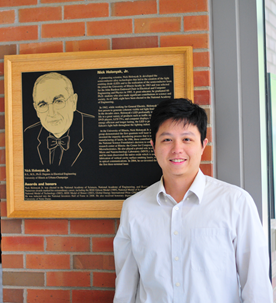
Chao-Hsin Wu received the B.S. degree in
Electrical Engineering and M.S. degree in
Graduate Institute of Photonics and
Optoelectronics from National Taiwan University,
Taipei, Taiwan, in 2002 and 2004, respectively.
He used to work as a full-time teaching
assistant in charge of Automatic Control Lab in
the Department of Electrical Engineering in
National Taiwan University from 2005 to 2006. He
then joined the High-Speed Integrated Circuit
group in University of Illinois at
Urbana-Champaign in 2006 and received the Ph.D.
degree in 2010. After finishing the Ph.D.
degree, he continued working as a postdoctoral
research fellow before he joined the faculty
member in National Taiwan University in 2011.
His research topics focus on the design,
fabrication, and characterization of high-speed
III-V semiconductor electronic and
optoelectronic devices, including heterojunction
bipolar transistors, field-effect transistors,
and microcavity lasers. The main interest is
developing the novel device, the light emitting
transistor (LET) and transistor laser (TL),
which is a three-port device with simultaneous
electrical and optical output. The device
demonstrates a fast-recombining carrier lifetime
(in picosec range) than conventional LEDs or
diode lasers, resulting in a resonance-free
laser response and 7 GHz spontaneous modulation
bandwidth (world record). It can help reduce the
cost, complexity, and heat problem of current
communication system. The "transistor-like"
building block is suitable for next-generation
photonic integrated circuit (PIC) application.
During his leisure time, he enjoys traveling
around and taking pictures. He also likes to go
to gym or play badminton to get some sweat. He
encourages students to develop some long-term
habits during their graduate life, and find out
what they really want in the future and start to
prepare for it at this moment. NTU has lot of
resources, but most important is that we are
surrounded by many talented people. Students
should take the opportunity to learn as much as
they can, and they don’t want to leave here with
nothing but a piece of paper. Take challenges
and do the best!
|
|
 |
|
 |
|
| |
|
 |
|
Fabrication of Si Waveguides from a Regular Si Wafer Exploiting
Laser Reformation Technique
Professor Ching-Fuh Lin's Laboratory
Graduate Institute of Photonics and
Optoelectronics, National Taiwan
University
Sub-wavelength optical wires fabricated
using CMOS (Complementary
Metal–Oxide–Semiconductor) compatible
techniques will lead the way to feasible
and economic integration of optics and
electronics. However, on the CMOS
transistor layer, which necessitates
thermal conduction through the silicon
substrate, the SiO2 layer
is very thin, so having more than a few
hundred nanometers of SiO2 underneath
the Si waveguide creates
incompatibility. In addition, CMOS
circuits are usually built on regular Si
wafers instead of o called SOI (silicon
on insulator) wafers. Here, we
investigate a novel method to fabricate
Si/SiO2 waveguides
from a regular silicon wafer rather than
SOI wafer. It allows the archtect of
great flexibility in design and fully
compatible with the CMOS circuitry.
As shown in Fig. 1, deep silicon ridges
were firstly created using typical
lithography and dry-etching process.
Then, high-power excimer laser was used
to illuminate the Si ridges. Under
proper illuminating condition, the Si
ridges would be melted and reshaped to
circular-profile structure. Finally,
high-temperature oxidation process was
used to oxidize the reformed structure.
The final oxidation of the neck of this
reformed structure prevents optical loss
due to light coupling from the waveguide
to the substrate. A structure with a
uniform round cross section was formed.
It exhibits a Si core with a diameter of
400 nm. The result shows the potential
of integrating electronics and photonics
on a single chip.
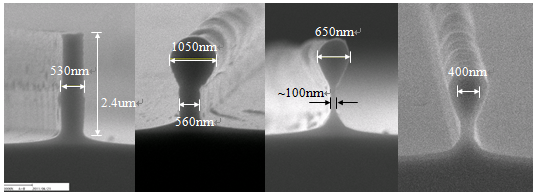 |
|
Fig. 1 SEM
images
of
fabricating
Si
waveguides
(a) a Si
ridge
from a
regular
Si
wafer;
(b) a
circular
structure
after
laser
reformation;
(c) the
structure
after
first
oxidation
and
removing
the
oxide;
(d) the
structure
after
second
oxidation. |
Efficient and
low-threshold Cr4+:YAG
double-clad crystal
fiber laser
Professor Sheng-Lung
Huang's Laboratory
Graduate Institute of Photonics and
Optoelectronics, National Taiwan
University
The ultra-broadband nature of
transition-metal-doped materials is
eminently suitable for applications,
such as petabit-bandwidth
telecommunications and
cellular-resolution optical coherence
tomography. Various Cr4+:Y3Al5O12 (Cr4+:YAG)
lasers in bulk-crystal forms have been
realized, yet poor thermal loading was
identified as one of the key factors
currently limiting the laser
performance. This renders bulk forms
difficult to implement as efficient,
compact, and affordable laser systems.
Recently, a double-clad architecture
grown by the codrawing laser-heated
pedestal growth (CDLHPG) technique was
successfully developed for broadband
light source and amplifier applications.
The fiber based waveguide geometry
features a high pump intensity and a
better heat dissipation, resulting in a
low-threshold Cr4+:YAG laser.
We report a significant advancement in
the performance of a compact, efficient,
low-threshold, and continuous-wave (CW)
Cr4+:YAG double-clad crystal
fiber (DCF) laser grown by the CDLHPG
technique. To our knowledge the
optical-to-optical slope efficiency of
33.9% is the highest ever reported for
Cr4+:YAG laser at room
temperature (RT) with just air cooling.
This efficiency improvement was achieved
by incorporating a strain-free Cr4+:YAG
DCF. The strain-free feature also
mitigates the photobleaching effect in
Cr4+:YAG. Additionally, a
self-selected linear polarized output
(>100:1) was attained by simply adopting
the orientated Cr4+:YAG gain
medium without introducing any
intracavity polarization-dependent
components. The impact of crystal
orientation on laser polarization and
the slight pump-induced laser
depolarization are also addressed.
Figure 1 shows the CW RT Cr4+:YAG
DCF laser output power versus the
incident pump power. The lasing
threshold Pth was
78.2 mW with an optical-to-optical slope
efficiency ηs up
to 33.9%. The laser was operated at RT
by just air cooling. The laser
performance agrees well with the
four-level Cr4+:YAG DCF
model. By taking advantage of the
strain-released crystalline core, the
extracted best-fit values of emission
cross section and fluorescence lifetime
were improved significantly compared to
that of strained core.
In conclusion, a Cr4+:YAG DCF
laser with a 33.9% optical-to-optical
slope efficiency and a 78.2-mW threshold
is demonstrated. This achievement was
obtained by reducing the distorted Cr4+ tetrahedron
via strain relief and photobleaching
mitigation. Realization of low-threshold
lasing with high slope efficiency at RT
for broadband gain medium at near
infrared wavelength range represents a
major step towards an affordable,
compact, and efficient active device for
applications ranging from
telecommunications to biomedical
applications.
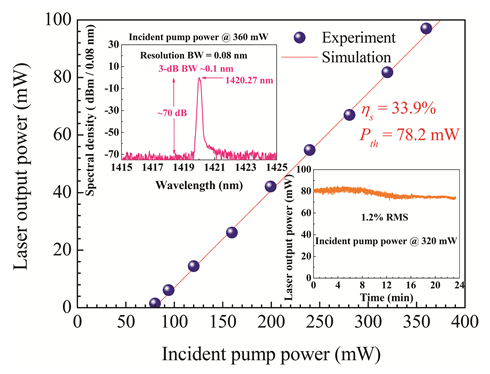 |
|
Fig. 1.
Cr4+:YAG
DCF
laser
output
power
against
the
incident
pump
power
achieved
at RT.
Upper
inset:
the
corresponding
lasing
spectrum
at the
maximum
incident
pump
power of
360 mW,
showing
a high
side-mode
suppression
ratio of
~70 dB.
Lower
inset:
stability
of the
Cr4+:YAG
DCF
laser
measured
every
100 ms
without
active
cooling
at RT. |
Low Loss Terahertz
Air-Core Pipe Waveguides
Professor Chi-Kuang Sun
Graduate Institute of Photonics and
Optoelectronics, National Taiwan
University
Terahertz (THz) technology has high
potential in a wide variety of
applications ranging from high-speed
telecommunications to bio-imaging. To
facilitate THz applications, it is
essential to develop low-loss and
low-cost THz waveguides. Recently, we
proposed a dielectric circular air-core
pipe for low-loss THz waveguiding. The
pipe waveguide is the simplest pipe with
a large air core region surrounded by
thin and low-index dielectric cladding.
Without complex fabrication, we used
commercial Teflon pipes to demonstrate
that the circular pipe waveguides not
only possess low attenuation constants
(< 0.001 cm-1)
and high coupling efficiency (> 80%),
but also suffer low bending loss. By
modifying the circular pipe waveguides
into rectangular ones, we further
removed the transmission degeneracy of
two orthogonal polarizations. It is
expected that these easily available,
low loss, low bending loss, and
polarization-sensitive THz waveguides
would have a high potential for THz
sensing, communication, and imaging
applications.
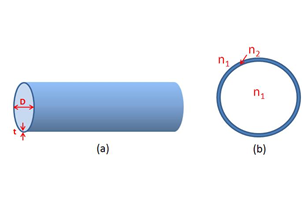 |
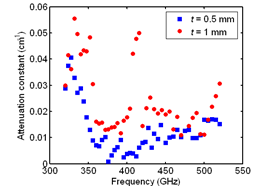 |
|
Fig. 1.
Structure
of the
pipe
waveguide.
(n1 =
1, air). |
Fig. 2.
Attenuation
spectra
of
straight
Teflon
pipe
waveguides
for t =
0.5 mm
and 1.0
mm. The
core
diameters
were the
same (D
= 9 mm). |
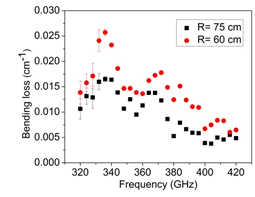 |
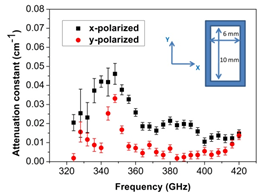 |
|
Fig. 3.
Bending
loss
spectra
of the
pipe
waveguide
for
bending
radius
of
curvature
(R) = 75
and 60
cm. |
Fig. 4.
Attenuation
spectra
of PE
rectangular
pipe
waveguides
for
different
polarizations. |
Beyond-Bandwidth
Electrical Pulse
Modulation of a TO-Can
Packaged VCSEL for 10
Gbit/s Injection-Locked
NRZ-to-RZ Transmissions
Professor Gong-Ru
Lin
Graduate Institute of Photonics and
Optoelectronics, National Taiwan
University
A TO-46-can packaged VCSEL with a finite
bandwidth of only 3 GHz has been
employed to demonstrate a 10-Gbit/s
all-optical NRZ-to-RZ data-format
convertor, as shown in Fig. 1. This
approach is based on the
injection-locking induced gain-switching
and the beyond-bandwidth
electrical-pulse modulation of the
TO-46-can packaged VCSEL biased at
nearly lasing condition. To support
10-Gbit/s RZ data pulse generation, the
resonant relaxation oscillation
frequency of this TO-46-can packaged
VCSEL is increased through direct
modulation by an electrical-pulse at 10
GHz and external NRZ optical injection
from 2 to at least 7.3 GHz. The
optimized 10-Gbit/s RZ data-stream
exhibits the signal to noise ratio, the
timing jitter, and the pulsewidth of 7.2
dB, 2.9 ps, and 27 ps, respectively. The
peak-to-peak chirp and corresponding
chirp parameter are slightly raised to
4.3 GHz and 122 MHz/ps by increasing the
injection power and the biased current.
Owing to carrier accumulation and gain
variation, the RZ data pulsewidth gets
reduced by increasing the optical NRZ
injection power and concurrently
increasing the DC biased current.
A higher DC biased current further
promotes the RZ data with greater
modulation depth and sharper shape. A
BER of 10-9 at
10 Gbit/s is achieved at a receiving
power of -19.5 dBm, and an improvement
of receiving power penalties up to 16 dB
is observed when the DC biased current
is reduced to only 10% of its lasing
threshold, as shown in Fig. 2. In
particular, the slope of the BER versus
receiving power significantly changes at
a receiving power of >-19 dBm. The major
reason for the slope change in the BER
curves is crosstalk between the
reflected incoming optical NRZ injection
and the output of the VCSEL converted RZ
data-stream. With a limited receiving
sensitivity of the 10-Gbit/s lightwave
receiver (Agilent 83434A), the VCSEL
converted RZ data-stream inevitably
introduces a noise floor in its BER
response. Despite the finite bandwidth
set by the homemade VCSEL, this work
demonstrates the feasibility of
operating the TO-can packaged VCSEL
based RZ generator beyond its intrinsic
modulation bandwidth with the aid of
electrical-pulse modulation and
externally optical injection. Most
concerns regarding the noisy data-stream
output can be addressed if the VCSEL can
tolerate a larger bias and thereby
achieve a better SNR before breakdown.
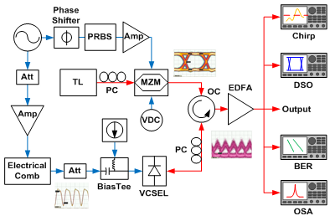 |
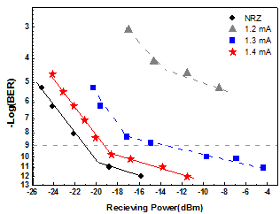 |
|
Fig. 1. VCSEL
based
10-Gbit/s
NRZ-to-RZ
convertor.
Amp:
microwave
amplifier;
MZM:
Mach-Zehnder
modulator;
OC:
optical
circulator;
PC:
polarization
controller;
TL:
tunable
laser;
Att:
attenuator;
DSO:
Digital
Sampling
Oscilloscope;
BER: bit
error
rate
tester;
OSA:
optical
spectrum
analyzer. |
Fig. 2. BER
analysis
of the
optical
NRZ from
a
externally
modulated
VCSEL
without
injection
(black),
and the
generated
RZ at 10
Gbit/s
from the
injection-locked
VCSEL at
DC bias
of 1.2,
1.3, and
1.4 mA. |
Reference:
Chia-Chi Lin, Yu-Chieh Chi, Hao-Chung
Kuo, Peng-Chun Peng, Connie Chang-Hasnain,
and Gong-Ru
Lin,
“Beyond-Bandwidth Electrical-Pulse
Modulation of a TO-can Packaged VCSEL
for 10 Gbit/s Injection-Locked NRZ-to-RZ
Transmission,” Journal
of Lightwave Technology,
Vol. 29, Issue 6, pp. 830-841, Mar.
2011.
|
|
|
 |
|
 |
|
| |
|
|
 |
|
 |
|
|
|